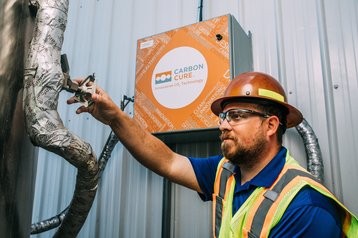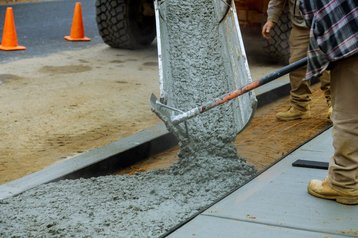There’s a massive source of emissions in your data centers - and you may not be aware of it. Before you even install any equipment, the building itself has already created tons of carbon dioxide and added to global warming - thanks to the concrete in the walls and floors.
Concrete is the second-largest source of greenhouse gases on the planet, contributing eight percent of the world’s CO2 emissions, making it a worse polluter than the airline industry. Every building put up adds a burden to the atmosphere, and the structural material of a data center contributes to its “embodied” environmental impact, before the equipment begins to use energy and create an “operational” environmental impact.
This feature appeared in the December Operations Supplement. Read it for free today.
A major polluter
Far-sighted data center operators are starting to pay attention to this. The most environmentally friendly approach is to avoid pouring new concrete where possible. Some companies, like France’s OVHcloud, make a point of always re-purposing buildings, to avoid the environmental impact of demolition and rebuilding.
Some hyperscale companies, that have to build new giant data centers, are paying attention to the impact of their concrete. In 2020, both Amazon and Microsoft invested in a company that reduces the emissions of the concrete industry, by injecting waste CO2 into the mix.
The company, CarbonCure, already has at least one customer in the data center industry: Compass Datacenters. It hopes to remove 500 megatonnes of carbon dioxide annually from the concrete industry by 2030.
For CarbonCure, the problem is much wider than data centers - because the world is in the throes of an orgy of building, which is constructing the equivalent of a new New York City every month.
“If concrete were a country, it would be the third-worst polluter after the US and China,” said Eric Dunford, director of sustainability at CarbonCure, in a recent online lecture for the American Institute of Architects (AIA).
“Most of the growth is coming from nations that are urbanizing and catching up with where the US and Europe are now,” said Dunford. “China has poured more concrete in the last three years than the US has poured in its entire existence as a nation.”
Concrete is made of a combination of aggregate - material like sand or gravel - and a cement which binds it together.
Cement is a fine powder which magically “cures” when water is added, forming insoluble crystals which bind the aggregate together. It’s wonderful stuff, but it’s an environmental villain: it makes up around 12 percent of the weight of the concrete, but produces 95 percent of its CO2 footprint.
“The emissions mostly come from a basic process that is impossible to do without if we want to have cement and concrete,” said Dunford. “We go out and dig up limestone deposits, also known as calcium carbonate. That enters a cement kiln, which is heated at a high temperature [2600°F/1400°C] under pressure, in order to get calcium oxide which is the precursor of cement.”
Heating the limestone to that high temperature obviously requires energy, and the energy source will produce emissions. But there’s a further cause of emissions: calcination.
Limestone is heated and loses water and carbon dioxide, becoming “clinker” which is largely calcium oxide. It is then ground into the fine cement powder used to make concrete. But when the calcium carbonate in limestone becomes calcium oxide, it gives off carbon dioxide.
“That CO2 is shot out of the stack and becomes part of the global CO2 in the atmosphere,” said Dunford.
Making a tonne of Portland cement creates 1.04 tonne of CO2, and other emissions are minimal by comparison, he says: “At the end of the day, for every tonne of cement that goes into your building, you’re looking at a tonne of CO2 being produced. Production and transport are minimal compared to the impact of the cement.”
There are a few ways to reduce the amount of emissions from concrete. The first is to reduce the emissions cement kilns cause, by shifting the fuel used to renewable sources.
The second, and most obvious, way to reduce emissions is to use less cement. Some low- emission concrete adds “fly ash” or slag to the mix, substances which don’t give off CO2 when heated.
However, they don’t have the binding power of lime (calcium oxide). Traditional concrete mixtures have a certain amount of cement tailored to produce the right strength and other properties.
There’s a third way to reduce the overall emissions of concrete, and that is to use the cement to capture and store carbon dioxide.
A carbon sink
“Carbon capture is the idea that if I capture CO2 that’s been emitted and find a way to store it somewhere out of harm’s way, that would be a good thing,” said Dunford. Efforts at carbon capture have been expensive and challenging, focusing on things like extracting carbon dioxide from polluting stacks, pumping it underground in oil wells, and trying to ensure it stays there.
As with most waste-disposal problems, it’s much better if it’s possible to find a route that turns the waste into something useful: “What if we found a way to uptake that CO2 that we see as a waste emission - and do something with it. If we make CO2 valuable, then we could find a way to create a market, take it from its sources and use it.”
What CarbonCure offers is “mineralization” taking CO2, and injecting it into the wet concrete before it sets. “The CO2 wants to find that other part of its original molecule and reform calcium carbonate,” said Dunford. “It reforms calcium carbonate inside concrete when it is being made.
In practice, CarbonCure sprays CO2 into the concrete as it is mixed. “That requires some math and science to figure out the right amount of CO2 the concrete can handle,” said Dunford.
The CO2 comes out of pressurized tanks as “dry ice,” said Dunford. “It looks a lot like snow - it’s like what comes out of a fire extinguisher.”
The fact that it’s solid is important: “Once it is injected, it rapidly reconverts into calcium carbonate as a solid material. There’s no bubbles of CO2 inside the concrete.” The process of stirring dry ice into concrete also means less than ten percent of the gas escapes into the atmosphere.
Somewhat surprisingly, there’s very little downside. While most of the strength of concrete comes from calcium silicates in the cured cement, the extra calcium carbonate increases the strength by ten percent.
That means that concrete makers can reduce the cement content, said Dunford. “Most of the time we want stronger concrete, and if you cut cement out of concrete, you see the strength go down,” he explained. “You can have concrete of same strength as you always had, but CO2 is part of the reason you achieve that strength.”
This magnifies the total savings: “You’re looking at about 25lb of CO2 reduction per cubic yard,” said Dunford. That’s coming from one pound of CO2 going into the mix, and 20lb to 40lb reduced by limiting the amount of cement going in. You can leverage this small amount of CO2 to get a bigger amount of reduction.”
Of course, it’s important to keep in context that this only offsets five percent of the total global warming potential of the context, because most of the CO2 emitted still goes up the smokestack, and it still takes a lot of energy to make the clinker in the first place.
Still, it can be combined with other efforts such as using fly ash and shifting fuels.
And it is a practical contribution. “CO2 mineralized concrete isn’t just a pipe dream,” Dunford said. “It’s not something that’s a lab experiment or sitting on some masters student’s desk. It’s something that is happening in real time.”
And in the context of a building, it stacks up well. For instance, Dunford cites a 350,000 square foot office building on a one-acre site, which used CO2 mineralized concrete: “It saved 680 tonnes of CO2 equivalent. That’s the equivalent of 800 years of a forest growing on that site.”
So far, the technique is only used in a small proportion of the world’s concrete. More than five million cubic yards of CO2-mineralized concrete have been produced, which sounds like good progress, but it is less than one-thousandth of the concrete the world uses in a year. Each year, more than five billion cubic yards (or nearly 10 billion tonnes) are poured.
The technique does require CO2 to arrive in pressurized cylinders, but that is how the world’s CO2 industry operates - and it is already gearing up to collect and use waste CO2 from industries such as ammonia-making and fossil fuel generation.
“CO2 comes from industrial suppliers,” said Dunford. “They scrub CO2 out of the stacks at oil and gas refineries or ethanol facilities or ammonia manufacturers, and they take that CO2 capture it and compress it and distribute it around.”
Dunford points out that if CO2-mineralized concrete provides a bigger market for that recovered CO2, it will stimulate a bigger effort to capture it. “As demand for CO2 rises in the concrete sector, you might see a number of things happen. You might see more installations, and greater capture.”
And that’s where the tech industry comes in. Companies such as Infosys and LinkedIn have used CO2-mineralized concrete in their headquarters in Indianapolis and San Francisco. “Private owners who care about this are jumping the gun,” said Dunford.
And data centers could be a good way to seed a steady demand. They are built to a price, but there’s a high profit margin in the industry, and a general awareness of environmental issues.
That’s why some data center companies are happy to pay the premium for CO2 mineralized concrete. In May 2020, Compass Datacenters made the change: "We estimate using CarbonCure will reduce our CO2 footprint by an average of 1,800 tons per campus," Compass CIO Nancy Novak said at the time. "That's the equivalent CO2 sequestered by 2,100 acres of forest or driving a car four million miles"
Amazon has promised to use CO2 mineralized concrete in its forthcoming HQ2 in Virginia, as well as its data centers - and gone further by investing in the company. A new investment round in September 2020 was led by Amazon’s Climate Pledge Fund and Breakthrough Energy Ventures, climate tech fund backed by billionaires including Bill Gates Jeff Bezos, Marc Benioff, Reid Hoffman, and Jack Ma. Microsoft has also invested.
In future, some governments may start to regulate to encourage the use of the material (there are already signs that New York might go that way, says Dunford). Those efforts will be much more likely to succeed if there’s already awareness of the possibilities.



